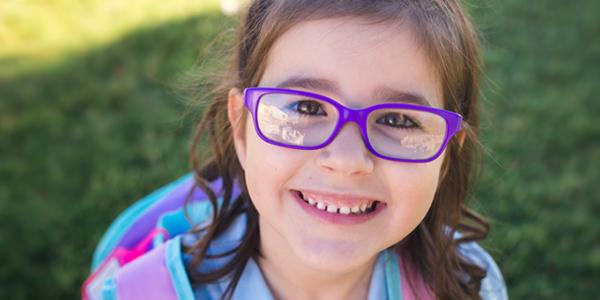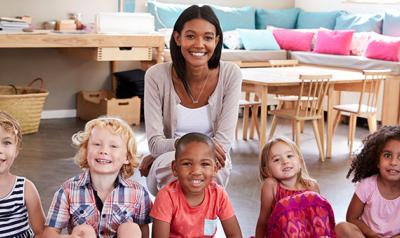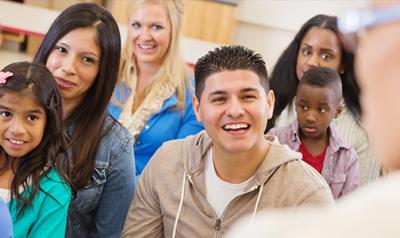A High-Quality School for Your Kindergartner

You are here
What an exciting time in your child's life! Five- and 6-year-olds make great leaps in learning and development. They gain a sense of personal responsibility, self-direction, and logical thinking. Everything your child learns in kindergarten will help her succeed in school and as an adult.
Kindergarten teachers want to help your child improve these skills and become a confident, curious learner. Find out how kindergarteners learn and develop, and how teachers support them. Let's get started!
Getting Ready for Kindergarten
Excited about your child going to kindergarten? A little worried? Many parents wonder if their child is ready for this next step. To prepare for this change, you can work on some things together.
Before he enters kindergarten, it's helpful if your child can:
- Take turns talking and listening to others
- Follow directions
- Play and cooperate with others
- Take care of personal needs, like using the bathroom and tying his shoes
- Choose his own activities and materials
- Spend time drawing, writing, cutting, and building
- Recognize a few letters, some letter sounds, and some numbers
- Count while doing everyday activities, like figuring out how many plates to put on the table for dinner
How teachers help. To help you and your child make a smooth transition to kindergarten, teachers might:
- Invite you and your child to visit the classroom and meet the teachers
- Send a welcome letter or email
- Ask about your child's health, favorite songs and books, and likes and dislikes
- Provide ways for you to ask questions and share information
- Recommend children's books about starting kindergarten and other new experiences
What you can do. Boost your child's confidence about starting kindergarten:
- Before school starts, visit the school together and meet your child's teacher.
- Read books together about starting school. Talk about what to expect, like riding the bus or going to the lunchroom.
- Switch to new bedtimes or wake-up times a few weeks before school begins. This helps your child get used to her new schedule.
- After the school year begins, ask your child to tell you about some of the children in her class. (This is less stressful for her than asking if she's made friends yet.)
- Ask the teacher how you can help your child learn at home and how you can get involved in the classroom.
How Kindergartners Learn and Develop
Through relationships with trusted adults. Every day, teachers help your child feel secure and important. From the morning hello until the end-of-the-day goodbye, teachers have warm interactions with your child. Children who feel safe and cared for grow in all areas of their development.
Through active, hands-on, “minds-on” play and learning. As your kindergartner explores, experiments, plays, and solves problems, he's learning concepts in math, language, science, social studies, and the creative arts. He discovers how to find answers to his questions. Your child also learns through playing and interacting with others. In a high-quality kindergarten, teachers combine play with learning.
By connecting new ideas and skills to what children already know and can do. We all learn best when we can connect new information to what we already know and are interested in. When a teacher reads a book to the class, he might say, “This is like the book we read yesterday. How did that story end? How is it similar to this ending?”
By exploring and making sense of their world. Kindergartners are active learners, figuring out the world around them. Teachers support this by providing interesting objects children can touch, explore, take apart, combine, and create with. They encourage children to investigate, experiment, and think about how or why something happens.
Through teacher-guided learning. Teachers carefully plan learning activities to give each child the right support. To help children better understand what they're learning, teachers
- Ask questions that help children think in new ways and explain their ideas
- Offer choices so children become more independent and more involved in their own learning: “Ramona, there are three activities in the science center today. Think about which one you'd like to do first.”
- Recognize each child's efforts and the results
- Add a challenge to stretch children's skills: “How many ways can you find to split this set of nine cubes, Haru?”
- Encourage children to think about what they learned
- Ask a child to share what he's learning with other children: “Look at the different seeds with your partner. Tell each other what you notice.”
Learning Centers
Many kindergartens have learning centers—different areas in the classroom where children experiment with materials, learn concepts, and practice skills. Centers can be filled with books, computers, drawing and writing supplies, things to build and create with, and materials for exploring math, science, and art. Teachers often set up center activities with specific learning goals. Working in centers helps your child get deeply involved in learning, apply concepts in different ways and situations, share space and materials, manage time, and develop a love of learning.
What Does “High Quality” Mean?
No two kindergarten classrooms look or feel exactly the same. Many teaching styles and methods can support your child's learning, but all high-quality classrooms share some features.
Teachers in high-quality schools build on what your child already knows and can do. They also help her stretch to learn what she doesn't know or can't do yet. Teachers use developmentally appropriate practice (DAP), which means that when they choose materials, activities, and strategies to support children's learning, they keep in mind
- What most kindergartners need—such as objects to count, measure, add and subtract, and make patterns with
- What individual children might need—like beginning level books that Vivian can read with help, and higher level books that Keyon can read on his own
- Ways to support each child's family background, language, and culture—such as labeling items in the classroom in Spanish as well as English for Lucia and Diego
To help children meet learning goals, teachers use what they know about individual children and what is important for all kindergartners to know. They also keep track of your child's progress.


